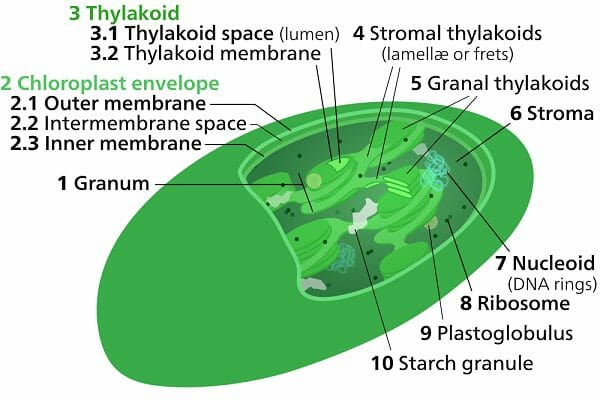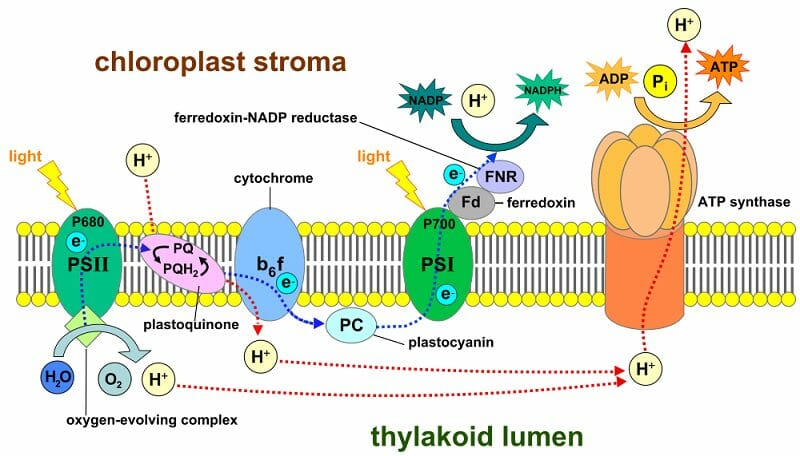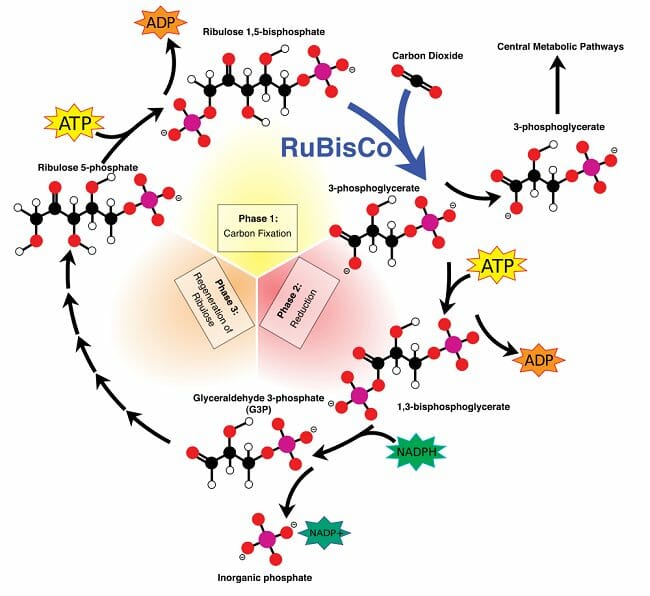Stroma Definition
Stroma commonly refers to the fluid filled inner space of chloroplasts surrounding thylakoids and grana. Initially, the stroma was thought to simply provide support for the pigmented thylakoids. However it is now known that the stroma contains starch, chloroplast DNA and ribosomes, as well as all the enzymes required for light-independent reactions of photosynthesis, also known as the Calvin cycle.
Derived from the Greek word for layer or bed covering, stroma could also refer to other supporting structures such as the connective tissues in organs or the fungal tissue that carries spores.
Structure of Chloroplast Stroma
Microscopic examination of the chloroplast reveals certain obvious features. It is made of an outer membrane and an intricate network of inner membranes, forming stacks of disc-like structures called grana. Different grana are connected to each other through membranous extensions.

The inner membranes contain chlorophyll and other photosynthetic pigments involved in harvesting light energy. Their obvious cytological appearance and the presence of primary pigments bestowed importance upon the inner membrane, grana and their component thylakoids. However, when the outer membrane of the chloroplast was broken, it was found that carbon fixation and reduction stopped. In other words, the transparent aqueous matrix or stroma, that appeared to merely support the pigmented substructures, seemed to play an important role in photosynthesis.
Chloroplasts evolved from free-living prokaryotes that formed an endosymbiotic relationship with some eukaryotic cells. Therefore, the stroma continues to contain DNA and ribosomes to perform protein synthesis. These proteins include those that are important in the light-independent reactions of photosynthesis as well as reactions that fix inorganic minerals such as nitrates in organic molecules.
Function of Chloroplast Stroma
The chloroplast is an unusual organelle because it carries out the most important activity of the plant cell while also containing its own genome. A number of genes necessary for its function have also been integrated into the nuclear genome. Therefore it needs to be able to modify its metabolic activity to complement the work of the cell. The stroma is essential for this because not only does it contain the enzymes necessary for carbon fixation, it also manages the chloroplast response to cellular stresses and signaling between various organelles. It plays an important role in both the light-dependent and light-independent reactions of photosynthesis. Under extreme stress, the stroma can selectively undergo autophagy without destroying the inner membranous structures and pigment molecules. Finger-like protrusions from the stroma, that do not contain any thylakoids are also seen to be closely associated with the nucleus and endoplasmic reticulum, contributing to sophisticated regulatory mechanisms.
Function in Photosynthesis
The stroma first begins to play a role in photosynthesis when the light energy captured by pigment molecules is converted into chemical energy through an electron transport chain.

Photosystems I and II (PSI and PSII) on the thylakoid membrane contain pigments that can harness light energy and use it to release high energy electrons. These electrons move through various membrane-bound proteins, such as cytochrome b6f complex or plastoquinone (pq), where simultaneous oxidation and reduction (redox) reactions occur. These reactions harvest some of the energy of the electron in addition to pumping protons against their concentration gradient from the stroma into the thylakoid lumen. When these protons flow back into the stroma, the action of a membrane-bound ATP Synthase powers the formation of ATP molecules. PSI is also involved in the formation of the reduced coenzyme NADPH in the stroma, through the activity of ferrodoxin. Thus, the stroma contains the end products of the light-dependent reactions – ATP and NADPH – setting the stage for the next steps in photosynthesis.
The most important enzyme in the light-independent reactions, or the Calvin cycle, is RuBisCO or Ribulose-1,5-bisphosphate (RuBP) carboxylase. This enzyme catalyzes the first step of the light-independent reactions involving carbon fixation. RuBisCO captures atmospheric carbon dioxide that has diffused into the chloroplast stroma and fixes it in the form of an organic molecule. Every molecule of CO2 combines with one molecule of RuBP, containing five carbon atoms, to give rise to two molecules of phosphoglycerate, which are three-carbon molecules.
The Calvin cycle has two more steps that occur in the stroma – reduction of phosphoglycerate and the regeneration of RuBP. These steps involve the use of ATP and NADPH. Overall, the light-independent reactions use two molecules of NADPH and three molecules of ATP to fix one molecule of atmospheric CO2.

Function in Stress Response
Abiotic stresses such as temperature or salinity fluctuations or nutrient deprivation can lead to the formation of finger-like protrusions from the chloroplast called stromules. Stromules have been observed in alpine plants exposed to higher temperatures. They do not contain grana or thylakoids and are also seen in greater numbers under the influence of nutrient deprivation or infection by pathogens. Under severe stress, the chloroplast attempts to respond to the event by selectively targeting stromal proteins for autophagy into a vacuole. This stress-induced autophagy is mediated by the formation of an isolation membrane that excludes thylakoids and grana. This membrane is eventually removed from the chloroplast and targeted for degradation in a vacuole. This process can be observed microscopically through the appearance of RuBisCO and other stroma-localized fluorescent proteins in the vacuole.
Function in Intra-Organelle Signaling
Chloroplasts are semi-autonomous because they contain their own genome, but also import a number of proteins and small molecules from the cytoplasm of the cell. Though they were initially free-living autotrophs, over evolutionary time, a number of their genes were transferred to the host nucleus. These genes are slightly modified so that the proteins are targeted to the chloroplast, and appear to be under the combined regulation of the nucleus as well as the chloroplast. Signaling from the nucleus to the plastid is called anterograde signaling and signals traveling toward the nucleus are called retrograde signals. Both these signals appear to be mediated through stromules, which also play a role in communication between two plastids.
Calvin Cycle: Light-Independent Reactions
The stroma is the site for the three steps involved in the Calvin Cycle – carbon fixation, reduction and regeneration.
Carbon fixation begins with the reaction between one molecule of CO2 and one molecule of RuBP. These six carbon atoms and two phosphate groups come together to form two molecules of phosphoglycerate, a three-carbon molecule containing one phosphate group. This reaction is repeated thrice to give rise to six molecules of phosphoglycerate.
In the next step, phosphoglycerate accepts electrons to form glyceraldehyde-3-phosphate (G3P). The driving force for this reduction reaction comes from the conversion of NADPH to NADP+ and ATP to ADP. Thus, ADP and NADP+ are regenerated for use in the light-dependent reactions.
This leaves one final step – the regeneration of RuBP. Of the six molecules of G3P generated in the previous step, five are used in the reformation of RuBP, and the sixth is exported from the chloroplast to make glucose.

Stroma in Animal Tissue
In animals, stroma refers to those cells and tissues that support the key functional elements of an organ. For instance, in a heart, the muscle fibers and neurons perform the main function, while the cells of the coronary circulatory system and immune system form the stroma. In addition, stroma also consists of non-cellular components such as collagen fibers, glycoproteins and glycolipids that provide the structural framework for the tissue and organ.
Examples of Animal Stroma
While the stroma in every tissue or organ has some generic roles such as transport of fuel and metabolites as well as structural support, in some organs, they have specific functions. The stroma in endocrine glands support the formation of hormones in the follicles and lobules of the organ. In the thymus, the stroma influences the differentiation of T-cells through positive or negative selection. Organs that need to respond quickly to the changing demands of the organism, such as the bone marrow or the iris of the eye, also need specialized stroma.
Stroma of the bone marrow
The stroma of the bone marrow is not directly involved in hematopoiesis, but creates the microenvironment that enhances the activity of cells involved in the formation of blood. The stroma produces growth factors, contains cells involved in bone metabolism, has fat cells as well as macrophages. Macrophages are particularly important because they are involved in the turnover of red blood cells and provide the iron needed for the production of hemoglobin.
Stroma of the iris
The human iris begins to form in the first trimester of gestation and is one of the few internal organs of the body that can be readily observed. The iris consists of a pigmented epithelium along with the muscles needed to constrict or dilate the pupil. These cells perform the primary function of the iris and are supported by a highly vascular stroma, a loose and interrupted connective tissue layer containing ligaments and pigment-forming cells. The presence of pigment screens the light falling on the eye and only allows some of it to pass through the pupil to form an image on the retina. This pigmentation is determined by the density and melanin present deep within the stroma with brown eyes arising from heavy pigmentation, and people having blue irises producing very little pigment.
Related Biology Terms
- Autophagy – Intracellular degradation system that delivers cytoplasmic components to the lysosome in animals or the vacuole in plants. Autophagy is important for a number of physiological functions, from nutrient turnover to stress response.
- Hematopoiesis – Formation of the cellular components of blood.
- Parenchyma – The functional tissue of an organ, especially used in contrast to the supporting stromal structures. Also refers to the cellular components of soft and succulent parts of leaves, fruits, barks and stems.
- Photosystem I and II – Multi-protein membrane-bound complexes that contain pigments which can harvest light energy and transfer that energy to electrons. They usually have a reaction center surrounded by light-harvesting complexes.
Quiz
1. What are grana in chloroplasts made of?
A. Outer membrane-bound proteins
B. Stacks of inner membrane structures
C. Chlorophyll
D. All of the above
2. Which of these is NOT a function of a chloroplast stroma?
A. Stress response
B. Intracellular signaling
C. Release of high energy electrons upon interaction with photons
D. All of the above
3. Which of these is NOT a function of stroma in animal tissues?
A. Structural support
B. Oxygen transport
C. Secretion of growth factors
D. None of the above
